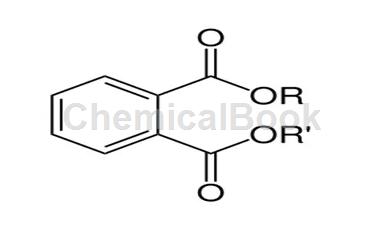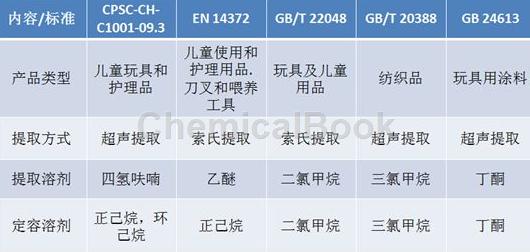Phthalates are involved in most chemical daily products, especially in the electronic field, and are one of the must-check items. However, the testing of phthalates is different internationally and domestically. What are the specific testing methods and standards?
Definition
Phthalates are the collective name for esters formed from phthalic acid. Mainly used in PVC materials to change PVC from hard plastic to elastic plastic and act as a plasticizer. It is widely used in hundreds of products such as toys, food packaging materials, medical blood bags and hoses, vinyl flooring and wallpaper, cleaners, lubricants, personal care products (such as nail polish, hair spray, soap and shampoo), etc. middle.

Phthalates in daily life
Phthalates in cosmetics can enter the body through women’s respiratory system and skin. Excessive use will increase women’s chances of breast cancer and harm the reproductive system of their future male babies. .
Soft plastic toys and children’s products containing phthalates may be put into children’s mouths. If left for a long enough time, the amount of phthalate dissolution will exceed safe levels and endanger children. The liver and kidneys can also cause precocious puberty in children.
During food processing, heating, packaging, and serving, phthalates may dissolve and penetrate into the food. For example: cling film covering food for microwave heating, plastic containers for food, plastic chopsticks, plastic gloves for eating hand-braised chicken, plastic water cups, beverage bottles, etc. may contain phthalates.
Interior decoration or household items; handbags, wallets, clothes, shoes and hats; plastic gloves or blood transfusion bags for medical use; electronic products such as mobile phones, headphones, mice; plastic necklaces, rings, bracelets, earrings and other decorations; gel pens , stationery bags, etc. may also contain phthalates.
Restrictions on Phthalates
2005/84/EC, REACH Annex 17 Articles 51 and 52, SVHC;
2015/863/EU;
GB 24613-2009 Limits of Hazardous Substances in Toy Paints;
GB 31701-2015 Safety Technical Specifications for Textile Products for Infants and Children;
GB/T 18885-2009 Technical requirements for ecological textiles;
OEKO-TEX Standard 100 International Environmental Protection Textile Association textile eco-label;
CPSIA (HR4040);
California 65;
SOR/2010-298
ST2012
Testing standards
GB 24613-2009 Limits of Hazardous Substances in Toy Paints Appendix C;
GB/T 20388-2006 Textiles – Determination of phthalates;
GB/T 21911-2008 Determination of phthalates in food;
GB/T 21928-2008 Determination of phthalates in food plastic packaging materials;
GB/T 22048-2008 Toys and children’s products Determination of phthalates in polyvinyl chloride plastics;
GB/T 24168-2009 Determination of phthalates in textile dyeing and finishing auxiliary products;
GB/T 28599-2012 Determination of phthalates in cosmetics;
GB/T 29608-2013 Rubber products – Determination of phthalates;
GB/T 29786-2013 Determination of phthalates in electronic and electrical products;
GB/T 30646-2014 Determination of phthalate content in coatings;
EN 14372:2004 Articles for use and care of children. Cutlery and feeding utensils. Safety requirements and tests 6.3.2;
EN 15777:2009 Textiles Test methods for phthalates;
ISO/TS 16181:2011 Footwear – Critical substances that may be present in footwear and shoe parts – Determination of phthalates in footwear materials;
CPSC-CH-C1001-09.3 Standard operating procedure for determination of phthalates;
ASTM D3421-75 Extraction and determination of plasticizer mixtures from vinyl chloride plastics;
ASTM D 7083-2004 (2010) Procedure for determination of monomeric plasticizers in polyvinyl chloride by gas chromatography;
ST 2012 1ST 1.9 Japanese Toy Safety Standard 1.9
HealthCanada Method C-34 Determination of Phthalates in Polyvinyl Chloride Consumer Products
Testing Principle
The sample is extracted by Soxhlet extraction, ultrasonic extraction or microwave extraction with a suitable solvent. The extract is purified and filtered as needed, concentrated to a constant volume, and analyzed by GC-MS.
The most commonly used detection methods
1. CPSC-CH-C1001-09.3 test
(1) Sample preparation
Cut the sample into small pieces with a diameter not exceeding 2mm.
(2) Dissolve sample
Accurately weigh at least 0.05g of sample, put it into a sample bottle, and add 5ml of tetrahydrofuran. If the mass of the sample is greater than 0.05g, add 10ml of tetrahydrofuran for every 0.1g of sample. Vortex, shake or sonicate for at least 30 minutes to dissolve the sample. If the sample cannot be dissolved and the sample is dissolved for a longer period of time, the sample solution is filtered through a 0.45um filter membrane and then analyzed by GC-MS.
(3) Precipitated PVC
If the sample contains PVC, mix 10ml n-hexane for every 5ml tetrahydrofuran and shake for 5 minutes to precipitate PVC.
(4) Filter test
Use a 0.45um PTFE filter to filter the sample solution, take 0.3ml of the filtered sample solution into a 2ml GC injection vial, add 0.2ml of internal standard solution (BB, 150mg/l), and then dilute to 1.5 with cyclohexane ml, GC-MS test analysis.
2. EN 14372:2004 test
(1) Sample preparation
Put the sample into a weighed 150ml flat-bottomed flask and bake it at 105±5℃Place it in the box for 30 ± 5 minutes, put it in a desiccator to cool, and then weigh the sample and flask. Cut the dried sample into small pieces with a diameter not exceeding 5mm.
(2) Soxhlet extraction
Accurately weigh about 2g of the sample into a Soxhlet extractor, add 50±10ml ether to Soxhlet extraction for 6±0.5h, cool and evaporate the ether in a water bath. Place the flask in an oven at 105±5°C for 30±5 minutes, cool it in a desiccator and then weigh it. Repeat the drying and cooling steps until the weight difference between the two weighings does not exceed 0.5 mg.
(3) Dissolution test
Add 50±2ml of n-hexane into the dried and constant-weight flask, shake to completely dissolve the extract, then transfer to a 200ml volumetric flask, rinse the flask with n-hexane several times and adjust the volume to the mark. The solution was passed through a 0.45um filter membrane and analyzed by GC-MS.
3. GB/T 22048 test
(1) Sample preparation
Make the sample into 5 × 5mm or less and mix it evenly.
(2) Soxhlet extraction
Accurately weigh about 1g of sample into a Soxhlet extractor, add 120ml of methylene chloride and perform Soxhlet extraction at 60-80°C for 6 hours, refluxing no less than 4 times per hour. After cooling, rotary evaporate at 50°C to approximately 10 ml. Dilute to volume with methylene chloride into a 25ml volumetric flask. If the concentrated solution is viscous or turbid, use a solid-phase extraction column to purify the concentrated solution (first activate with 3 ml of methylene chloride, then rinse with 3 × 3 ml of methylene chloride, collect the eluent and eluent for determination Allow). The sample solution was analyzed by GC-MS after passing through a 0.45um organic filter membrane.
4. GB/T 20388 test
(1) Sample preparation
Take a representative sample, cut it into pieces below 5 × 5mm, and mix evenly.
(2) Ultrasonic extraction
Accurately weigh about 1g of sample into a 100ml stoppered Erlenmeyer flask, add 30ml of chloroform, and conduct ultrasonic extraction for 20 minutes. The extract was filtered into a 50ml volumetric flask. The residue was extracted ultrasonically with 20 ml of chloroform for 5 min. The filtrate was combined and diluted to volume with chloroform. The sample solution was analyzed by GC-MS after passing through a 0.45um organic filter membrane.
5.GB 24613 Appendix C Test
(1) Sample preparation
Stir the liquid sample evenly and prepare a mixed sample according to the proportion, and crush the solid sample to make the particle size less than 5mm.
(2) Ultrasonic extraction
Accurately weigh about 1g of sample into a 50ml stoppered Erlenmeyer flask, add 20ml of butanone, and conduct ultrasonic extraction for 20 minutes. The extract was filtered into a 50ml volumetric flask. The residue was extracted ultrasonically with 20 ml chloroform for 5 min. The filtrate was combined and diluted to volume with MEK. The sample liquid was tested and analyzed by GC-MS after passing through a 0.45um organic filter membrane.
Comparison of differences between various test methods:

Detection precautions
1. Occasionally there will be samples with high content during phthalate testing, and the utensils must be cleaned. Sample bottles and injection vials need to be baked at high temperature to remove organic pollutants and prevent contamination;
2. Phthalate esters have a large response value on GC-MS. It is recommended to use a split ratio of 20:1 or higher for injection during testing;
3. The glue may contain high levels of phthalates, which will have a great impact on the test results. You must pay attention when taking samples. Please note if the sample contains glue;
4.DINP is a group of peaks, and there may be false positives. It needs to be compared and analyzed with the standard for confirmation. Only when the ion ratio and peak time are consistent can the integration calculation be performed.

 微信扫一扫打赏
微信扫一扫打赏

